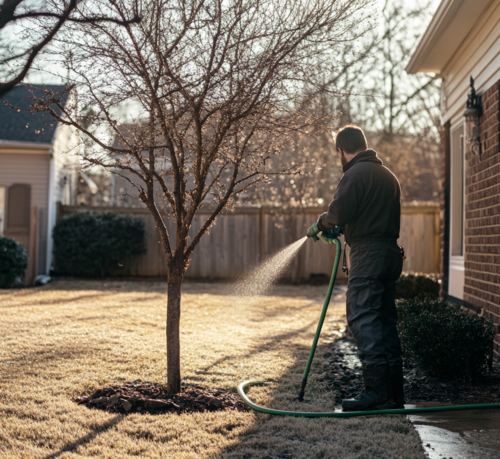Top Tips for Dealing with Snow and Ice on Your Trees
Introduction
Winter can be harsh on your trees , shrubs, and plants, with heavy snow and ice causing stress, damage, and even breakage. By understanding how to care for your landscape during the colder months, you can protect your investment and maintain a healthy, vibrant yard. Below are detailed tips to help your trees survive and thrive during winter , ensuring their safety and health as spring approaches.
Avoid Shaking Branches Covered in Ice and Snow
Snow and ice accumulation can put immense pressure on tree branches, leading to breakage. While your first instinct may be to shake off the weight, this can cause sudden stress, exacerbating the problem.
Why You Shouldn’t Shake Snowy or Icy Branches
Branches covered in ice are already brittle, and shaking them can cause splintering or breakage at weak points. This damage not only affects the branch but also compromises the tree’s overall structure and health.
What You Should Do Instead:
- Let Ice and Snow Melt Naturally: In many cases, the safest option is to let sunlight and warmer temperatures melt the accumulation. Trees have evolved to endure winter weather, and most can handle moderate snow and ice.
- Brush Snow Off Gently: Use a soft broom to lightly sweep snow off branches if the accumulation is excessive . Brush upward from underneath the branch rather than downward to prevent snapping.
- Trim Broken Branches Immediately: If a branch does break, prune it cleanly at the break point to prevent further damage or disease. Use clean, sharp tools to make the cut as smooth as possible.
Long-Term Benefits:
Proper handling of snow and ice on branches helps preserve the tree’s structural integrity and promotes faster recovery in the spring.
Continue Watering Your Trees

Proper Winter Watering for Healthy Tree Growth
Many homeowners overlook winter watering, assuming their trees don’t need moisture in colder weather. However, even during the dormant season, trees require water to stay healthy.
The Importance of Winter Hydration
- Prevents Root Desiccation: Dry soil combined with cold winds can cause roots to lose moisture, a condition known as winter desiccation.
- Improves Cold Tolerance: Trees that are well hydrated are better equipped to endure freezing temperatures and bounce back in spring.
Winter Watering Tips:
- Water Before Freezing Temperatures: Continue watering trees deeply until the ground freezes. This helps saturate the root zone, ensuring moisture availability during dry spells.
- Water During Thaws: If a midwinter thaw occurs, take the opportunity to give your trees a light watering.
- Protect Younger Trees: Young trees with shallow root systems are especially vulnerable to winter drought. Use mulch around the base to retain soil moisture and regulate temperature.
Keeping your trees hydrated is a simple yet effective way to ensure they survive winter stress.
Prune Regularly to Minimize Damage

Expert Winter Pruning for Tree Health and Safety
Winter is one of the best times for pruning, as trees are dormant, making it easier to spot structural issues and potential weak points. Proper pruning also reduces the risk of damage from heavy snow and ice storms.
Why Winter Pruning is Beneficial
- Reduces Weight on Branches: Removing weak or dead branches decreases the likelihood of breakage under the weight of snow.
- Prevents Disease Spread: Pruning during dormancy minimizes the risk of infections spreading through open cuts.
- Encourages Healthy Growth: Strategic pruning shapes the tree and promotes robust growth in spring.
How to Prune Effectively:
- Inspect After Storms: After snowstorms, check for cracked or broken branches. Remove them promptly to prevent additional stress.
- Prune Early in the Season: Perform a thorough pruning at the start of winter to remove deadwood and vulnerable limbs.
- Focus on High-Risk Trees: Pay close attention to trees near structures, power lines, or pathways to avoid potential hazards.
Regular pruning ensures that your trees remain healthy and reduces risks associated with winter weather.
Use Salt Sparingly and Strategically

Using Plant-Safe Deicing Agents to Protect Winter Landscaping
Deicing agents like salt are essential for safety but can severely harm trees and plants. Salt draws moisture away from the soil and roots, leading to dehydration and damage.
Common Signs of Salt Damage
- Brown Needles on Evergreens: Salt spray can cause discoloration or browning of needles.
- Leaf Scorch: Deciduous trees may exhibit wilting or curling of leaves in spring if salt damage occurs during winter.
- Stunted Growth: Chronic salt exposure weakens trees over time, affecting growth and vitality.
Tips for Using Salt Around Trees:
- Use Tree-Safe Deicing Alternatives: Look for calcium magnesium acetate or other products labeled safe for plants.
- Create Barriers: Install burlap screens or other barriers to shield trees from salt spray and runoff.
- Dilute with Sand or Gravel: Mixing salt with sand minimizes its concentration while maintaining traction.
- Flush the Soil: In spring, water the soil thoroughly around trees to wash away residual salt and restore soil health.
By using salt thoughtfully, you can balance safety with protecting your landscape.
Know When to Call a Professional
When snow and ice storms leave your trees damaged or unsafe, seeking professional help ensures the best outcome for both your property and your trees.
Why Hire a Tree Care Professional?
- Specialized Expertise: Arborists are trained to assess tree health and structural integrity, providing informed recommendations.
- Safe Ice Removal: Professionals use advanced tools and techniques to safely remove snow and ice without harming the tree.
- Preventative Measures: They can offer long-term strategies to strengthen your trees against future storms.
What to Expect from a Professional Service:
- Comprehensive Inspections: Experts can identify hidden damage that may not be obvious to the untrained eye.
- Pruning and Debris Removal: Skilled pruning and cleanup ensure the tree’s recovery and safety.
- Emergency Services: If a tree poses an immediate risk, arborists can remove or stabilize it safely and efficiently.
To Wrap Up
Caring for your trees during winter is essential for their long-term health and safety. By avoiding unnecessary stress on branches, maintaining proper hydration, pruning strategically, using deicing agents sparingly, and seeking professional help when needed, you can protect your landscape from winter’s challenges.
Originally posted on January 31, 2019.


